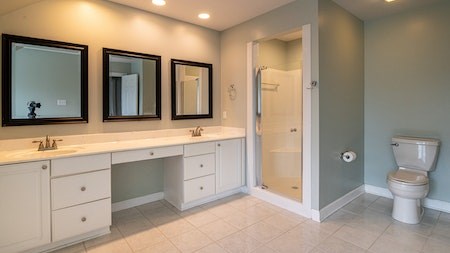The purpose of bathrooms is to serve hygiene and health purposes. However, constant exposure to water and steam provides an ideal environment for the growth of harmful bacteria and fungi.
To avoid health hazards and unpleasant odours, you need to make sure your bathroom is spotlessly clean.
Mould
It is sometimes difficult to keep a bathroom adequately ventilated, and a lack of airflow can lead to the build-up of unsightly – and unhealthy - mould and mildew on shower screens, curtains, walls, sealant and grout.
- To prevent mould build-up, open the window or switch on the extractor fan. If your bathroom doesn’t have a fan consider installing one.
- To clean discoloured grout and tiles and any other mould in the bathroom, apply mould removal spray to the mouldy surfaces and leave for 30 minutes or longer. Then scrub with an old toothbrush or dishwashing brush and rinse with clean water. Keep the windows and doors open to minimise the effects of chlorine fumes.
- To remove mould or mildew on shower curtains, wash them in the washing machine or soak them in a warm water bath with a cup of biological detergent added. Soak your heavily stained curtains in a weak bleach solution to remove mould.
- To help prevent fungal growths, dry off shower screens and doors with a small squeegee after each use and leave the door ajar.
Limescale
In hard water areas, shower screens will quickly cloud over, and taps will develop white, chalky deposits around bases and spouts.
To prevent this, you should use a limescale remover on bathroom fittings once a week.
- Never use abrasive cleaners on taps. Instead, soak a cloth in a solution of equal parts: white vinegar and water or a descaling product to remove limescale deposits. Wrap the cloth around the tap, leave for a few hours, then remove it and rinse and dry the tap.
- Descale shower heads once a month with a liquid descaler and an old toothbrush. Alternatively, detach the showerhead and soak it in a solution of half white vinegar and half water for two hours. Use a needle to unclog any spray holes that are still blocked.
- Before you wipe down the shower screens and door, spray on a commercial shower cleaner or a mix of one-part white vinegar to one part water in a spray bottle. It only takes a few minutes to do and will save you hours removing limescale deposits at a later stage.
Drains
To avoid standing in the shower in ankle-deep soapy water, you need to clean the drain regularly.
- Once a week, remove the drain cover and clear out any hair or other items obstructing water flow.
- Once a month, pour a kettle filled with boiling water over a cup of washing soda crystals scattered around the drain. This will help clear grease and soap scum, eliminate odours and leave drains running freely.
- A mixture of vinegar and bicarbonate of soda will dissolve any dirt around the basin, and bath drains and lemon juice can help remove strong smells.
- Finish off with lots of hot water.
- For more stubborn drains and blocked basins, half fill the basin or bathtub with water and use a plunger to clear the blockage.
Baths
A long soak in the tub - with a bath bomb or oils - is great for relaxing after a hard day’s work. Unfortunately, bath additives and soap can set overnight and become difficult to remove.
- To get rid of tidemarks and built-up grime, spray the areas liberally with your usual bathroom cleaner and let it soak in for at least 15 minutes before wiping and rinsing.
- If the bath is really dirty, fill it with warm water, add a few scoops of biological washing powder, and soak overnight. Wipe down and rinse thoroughly before bathing.
- Ideally, make it a firm rule that everyone must rinse the bath immediately after they use it.
Toilets
The toilet is the one item in the home where even eco-conscious homeowners would probably use bleach to keep it germ-free.
Once a week, spray toilet cleaner under the lip and leave for 15 minutes before scrubbing with a toilet brush. Flush with clean water.
Once a week, clean the toilet brush by placing it in the toilet bowl, pouring some bleach in the water and leaving it to stand for at least 15 minutes. Fill the brush holder with warm soapy water and a few drops of bleach, then swish it around and empty it into the toilet. Flush clean water over the brush and replace it in the holder.
The tips listed above are cost-effective, easy to implement and will assist you in having a clean, healthy, and enjoyable bathroom.
Writer : Sarah-Jane Meyer




